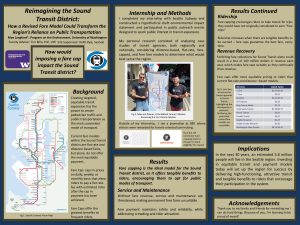REIMAGINING THE SOUND TRANSIT DISTRICT: HOW A REVISED FARE MODEL COULD TRANSFORM THE REGION’S RELIANCE ON PUBLIC TRANSPORTATION
The United States transportation sector is responsible for 28% of the nation’s total greenhouse gas emissions, and private vehicle ownership is rising. An estimated 5.8 million people will live in the Seattle region in the next 30 years, and creating targeted equitable Light Rail expansion has more power than ever to create urban spaces where walking and transit are the most convenient modes of transportation. Without a fare model with rider benefits that ensure equity and affordability, however, riders can be priced out, or opt out of taking transit. The purpose of this study was to consider all the benefits and drawbacks of the fare-capping model, used by many major U.S. transit agencies, and consider its implications for application in the Sound Transit District. To accomplish this, I analyzed case studies from local and regional transit agencies that utilized this fare model and considered the following as my primary criterion: revenue recovery, ridership (current riders and new riders), and service and maintenance. Findings suggest that there are significant improvements for riders when fare capping is introduced including reduced financial burden, streamlined fare policies across agencies, standardizing revenue recovery, and increased engagement with transit. Although there is no single system that will satisfy all riders and their ability or willingness to pay, prioritizing a fare model that is simple, compatible with the entire Sound Transit district, and designed with rider benefits in mind is necessary for long-term ridership and engagement in transit.
